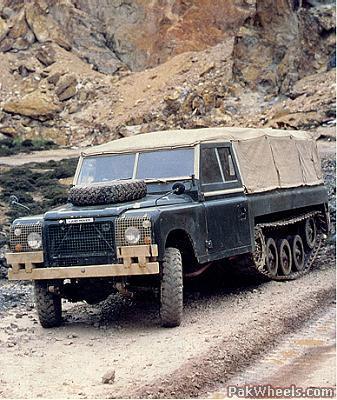The Centaur
This Landrover was half Stage1 and half light tank. The front end was all Solihull's finest but the rear was a shortened version of the Scorpion light tank tracked bogie. The resulting half-track had a very high payload and formidable offroad potential but didn't attract military orders, so the project was stopped in 1980 after one more prototype had been built with 110 front end.
Engine: V8 petrol 3.5 litre
132 bhp at 5000rpm, 185 lbft at 2500
Ignition: coil, 12 Volts
Differentials 3, positive lock on inter axle differential
Steering Burman recirculating Ball
Brakes Front: Hydraulic drums
Rear: Inboard discs, each with twin calipers front and rear, servo assisted
Suspension Semi-elliptic leaf springs/coils, track: each wheel independent torsion bar
Track MoD design, light stell with bonded rubber road pads and central horn, tesioning by hydraulic ram on rear idler wheel, 14 tooth twin sprockets
Weight Unladen: 3880 kg, Laden: 6970 kg
6 prototypes of this superb vehicles were built. On the first 2, P1 and P2 work begun on October 1978, the other 4 at about one month intervals. P1 to P3 were right hand drive, the other 3 left hand drive. P1 and P4 were 12 Volts, the other combined 12/24 Volts. All were initially designed as softtops.
They suffered many problems even being straight from the standard line for most parts. The repeatedly suffered power losses, front prop shaft faillures and burnt clutches were reported. Front axle half shafts failed often but could be traced back to a faulty design. Steering on road at very high speeds was superb. In slow goin and offroad the vehicle is horribly directionless which is quite obvious as the tracks do not help in steering. The tracks have no return rollers, so at any speed they hit the bottom of body. The noise is deafening, LR measured 108 decibels! Also the vibrations are very annoying, causing the rear differential mounting to crack. Most of these problems would have been solveable but the British army could not decide on placing a large order. Meanwhile the airlifted units and rapid ground forces gained importance and no other army wanted to take the sirk of buying them first.
P1 was completed in late April 79' and tests were made at Anglesey (picture below) and at the MIRA test track to a total of 3480 miles until end of June. The covered distance equalled a 10 years service life. Upcoming problems were the rear and front driveshafts and some small weak spots on the chassis. These and other minor problems were quickly mended. After these trials P1 was transported to Norway for 3 months winter testing. Here it performed admirably, outperforming most other vehicles. It is believed that P1 went to Libya and never returned.
P2 was shown in Nigeria on a sales tour and later in Kenya. This fully restored vehicle now belongs to the Peter Blanchard Collection.
P3 was altered to be a hard top communications vehicle. It was equipped ith UHF and HF radios, field telephones, teleprinters and sniper detection radar. Now it carries a standard soft top and also belongs to the Peter Blanchard Collection.
P4 was extensively tested in Oman and the Sultan of Oman insited on paying for it, so it was sold. This one appeared on many sales publications, carrying 2 machine guns. It is possible that this one is now in a private regimental museum in Britain, apparently being equipped with an Chevy 5.7 litre V8 and an automatic gearbox.
P5, completed in late summer 79' was mainly used as demonstrator. It was seen on exercise in Germany and was trialled with an anti-personnel mine discharger. In spring of 1980 it got a 20mm cannon fitted on a cargo bed. Later is was flown to the Persian Gulf for more demonstartions. Today it belongs to the Tank Museum in Bovington. This the one shown in the picture above (Billings 1998)
P6 went to Iraq for demonstrations, came back later that year. It is believed it returned to Iraq and stayed there but this is not confirmed.
Another one was built using 110 front end parts and an eighth tracked hull . Today it also belongs to the Tank Museum. Contrary to the others it was finished in sand color.
The end of the project came in 1984 when political and economic changes killed off most of the potential export markets and so the project was cancelled.


